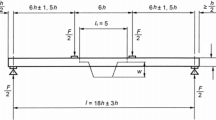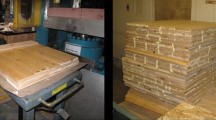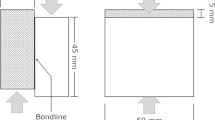Abstract
Cross-laminated timber (CLT) laminates layers of laminae side by side, with the fiber direction of each layer orthogonal to each other. Therefore, any error in the thickness of the laminae may cause gaps in the glue lines, leading to adhesion failure. In this study, a three-layer CLT with a thin lamina inserted in the inner layer was manufactured, and the gap-filling performance of adhesives and the allowable error for lamina thickness were investigated. The outer layer of CLT was arranged with 30.0 mm-thick laminae, and the inner layer alternated between 30.0 mm-thick lamina and thinner laminae (29.9, 29.7, and 29.5 mm). One-component polyurethane adhesives (PUR), emulsion polymer-isocyanate (EPI) adhesives, and phenol-resorcinol–formaldehyde resin (PRF) were used. The glue line thickened when the lamina thinned down in PUR and EPI. By contrast, the glue line thickness at the lamina thickness of 29.5 mm in PRF was almost the same as the glue line thickness without gaps. PUR demonstrated low delamination and a high wood failure rate (WF) even at 0.5 mm lamina thickness error, meeting the criteria set by the Japanese Agricultural Standard (JAS). Conversely, EPI failed to meet the JAS requirements for a lamina thickness error exceeding 0.3 mm. On the other hand, PRF exhibited favorable adhesive performance within a 0.3 mm lamina thickness error, with delamination and WF meeting the criteria of the standard.








Similar content being viewed by others
Data availability
The data used in this study is available from the corresponding author on reasonable request.
References
Betti M, Brunetti M, Lauriola MP, Nocetti M, Ravalli F, Pizzo B (2016) Comparison of newly proposed test methods to evaluate the bonding quality of cross-laminated timber (CLT) panels by means of experimental data and finite element (FE) analysis. Constr Build Mater 125:952–963. https://doi.org/10.1016/j.conbuildmat.2016.08.113
Brandner R, Flatscher G, Ringhofer A, Schickhofer G, Thiel A (2016) Cross laminated timber (CLT): overview and development. Eur J Wood Prod 74:331–351. https://doi.org/10.1007/s00107-015-0999-5
Casilla RC, Pirvu C, Wang BJ, Lum C (2011) Block shear testing of CLT panels: an exploratory study. Transformative Technologies #TT1.07 Test report 2010/11, FPInnovations, Vancouver BC, 2011.
Caster R, Gillern M, Howell J (1973) A gap-filling phenol-resorcinol adhesive for laminating. For Prod J 23:55–59
Clauß S, Joscak M, Niemz P (2011) Thermal stability of glued wood joints measured by shear tests. Eur J Wood Prod 69:101–111. https://doi.org/10.1007/s00107-010-0411-4
Elbez G (1989) Expanding resorcinol cold-sets for gap-filling adhesives for wood. In: Pizzi A (ed) Wood adhesives: chemistry and technology, vol 2. CRC Press, pp 389–408
Goto T, Kawamura M, Sakuno T (1963) Studies on the gap-filling property of wood adhesives. Wood Res Bulletin Wood Res Institute Kyoto University 31:59–74 (In Japanese)
Ishihara W, Takanashi R, Ohashi Y, Miyazaki J, Nakashima S, Miyatake A, Shindo K (2021) Bonding strength between cross layers of CLT evaluated by torsion and compression block shear tests. Mokuzai Gakkaishi 67:100–108. https://doi.org/10.2488/jwrs.67.100 (In Japanese)
ISO 16696-1 (2019) Timber structures - Cross laminated timber Part 1: Component performance, production requirements and certification scheme
JAS 3079. Japanese Agricultural Standard for Cross-laminated timber (2019) (In Japanese)
Kim HK, Oh JK, Jeong GY, Yeo HM, Lee JJ (2013) Shear performance of PUR adhesive in cross laminating of red pine. J Korean Wood Sci Technol 41:158–163. https://doi.org/10.5658/WOOD.2013.41.2.158
Knorz M, Torno S, van de Kuilen J-W (2017) Bonding quality of industrially produced cross-laminated timber (CLT) as determined in delamination tests. Constr Build Mater 133:219–225. https://doi.org/10.1016/j.conbuildmat.2016.12.057
Kurt R (2006) Effect of glue line thickness on shear strength of wood-to-wood joints. Wood Res 51:59–66
Lehringer C, Gabriel J (2014) Review of recent research activities on one-component PUR-adhesives for engineered wood products. Materials and joints in timber structures. Springer, Netherlands, Dordrecht, pp 405–420
Marra M, Negri M, Guercini S, Ceccotti A (2012) Assessment Process of a New Structural PUR Adhesive. In: World Conference on Timber Engineering. Auckland, New Zealand, p. 482–486
Miyamoto K, Tohmura S, Hayashi S, Hanai A, Ikeda T (2015) Evaluation of gap-filling properties of adhesives for wood structural materials. In: Programs of the 65th Annual Meeting of the Japan Wood Research Society. J18–08–1045 (In Japanese)
Muszynski L, Hansen E, Fernando S, Schwarzmann G, Rainer J (2017) Insights into the global cross-laminated timber industry. Bioprod Bus 2:77–92
R Core Team (2022). R: a language and environment for statistical computing. R Foundation for Statistical Computing, Vienna, Austria. URL https://www.R-project.org/
Sikora KS, McPolin DO, Harte AM (2016) Shear strength and durability testing of adhesive bonds in cross-laminated timber. J Adhes 92:758–777. https://doi.org/10.1080/00218464.2015.1094391
Ukyo S, Shindo K, Miyatake A (2019) Evaluation of rolling shear modulus and strength of Japanese cedar cross-laminated timber (CLT) laminae. J Wood Sci 65:31. https://doi.org/10.1186/s10086-019-1810-8
Vick C (1973) Gap-filling phenol-resorcinol resin adhesives for construction. For Prod J 23:33–41
Acknowledgements
The authors are thankful for financial support for the project “Development of Advanced Utilization Technology for Logging Wood” (2013-2017) of the “Development of mitigation and adaptation technologies to climate change in the sectors of agriculture, forestry, and fisheries” commissioned by the Agriculture, Forestry and Fisheries Research Council Secretariat. We would like to thank Oshika Co. Ltd. for providing adhesives and advice on adhesive application.
Funding
This research was funded by the project “Development of Advanced Utilization Technology for Logging Wood” (2013–2017) of the “Development of mitigation and adaptation technologies to climate change in the sectors of agriculture, forestry, and fisheries”, which was commissioned by the Agriculture, Forestry and Fisheries Research Council Secretariat.
Author information
Authors and Affiliations
Contributions
JM wrote the main manuscript text. JM, KM, ST, YO and KM devised a research plan. JM, KM, YO, NF, and RT conducted the experimental work and analyzed the data. All authors reviewed the manuscript.
Corresponding author
Ethics declarations
Conflict of interest
The authors have no competing interests to declare that are relevant to the content of this article.
Ethical approval
Not applicable.
Additional information
Publisher's Note
Springer Nature remains neutral with regard to jurisdictional claims in published maps and institutional affiliations.
Rights and permissions
Springer Nature or its licensor (e.g. a society or other partner) holds exclusive rights to this article under a publishing agreement with the author(s) or other rightsholder(s); author self-archiving of the accepted manuscript version of this article is solely governed by the terms of such publishing agreement and applicable law.
About this article
Cite this article
Miyazaki, J., Miyamoto, K., Tohmura, Si. et al. Gap-filling properties of adhesives used for cross-laminated timber. Eur. J. Wood Prod. 82, 123–134 (2024). https://doi.org/10.1007/s00107-023-01981-0
Received:
Accepted:
Published:
Issue Date:
DOI: https://doi.org/10.1007/s00107-023-01981-0




